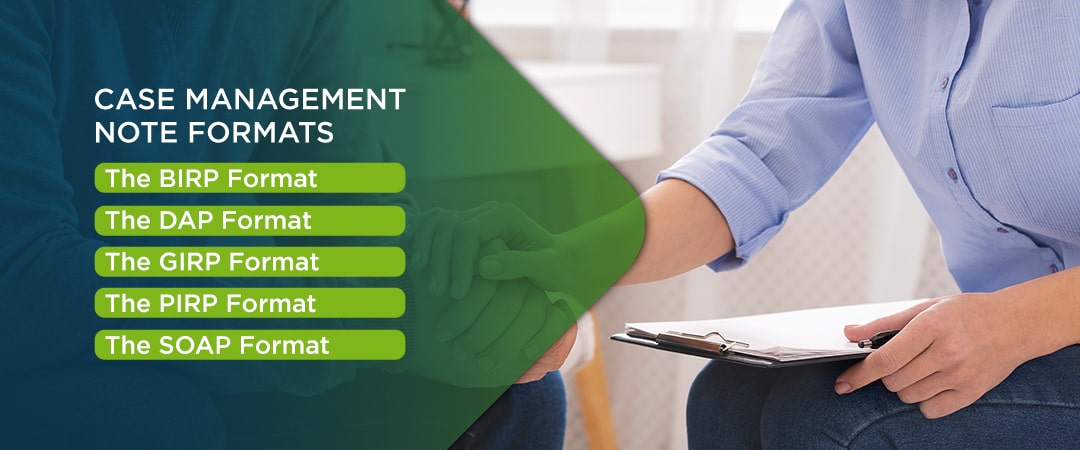
Writing Effective Case Management Notes
Effective case management notes and documentation play a pivotal role in the delivery of behavioral health and lifestyle services. Case managers serve as advocates for patients across diverse social services, aiming to enhance their clients' wellness and independence. This collaborative approach integrates various disciplines to assess, strategize, coordinate, implement, and evaluate tailored services for each individual.
Given the dynamic nature of client needs, case managers meticulously document progress, goals, and treatment responses in their case management notes. These records serve as critical tools in ensuring comprehensive care and continuity of support.
Free Download: Case Management Note Checklist

Case Management Note Formats
There are several formats that are utilized to write case management notes. It is up to the individual facility or group to determine the exact format such as SOAP, DAP, GIRP, PIRP, BIRP, or standard case management progress notes.

- SOAP: This acronym stands for Subjective, Objective, Assessment, Plan.
- DAP: This acronym stands for Data, Assessment, Plan.
- GIRP: This acronym stands for Goal, Intervention, Response, Plan.
- PIRP: This acronym stands for Problem, Response, Intervention, Plan.
- BIRP: This acronym stands for Behavior, Intervention, Response, Plan.
Elements of an Effective Case Management Note
Ideal case manager notes are timely, clear, concise, accurate, readable, and most importantly factual. Whatever the note type a detailed and effective case management note will consist of the following:

1. Accurate and Complete
One of the best practices for writing your notes is ensuring they are accurate and complete. Not only should you include a brief description of the interaction, but you may also want to add details relevant to this specific case that can help another person read your notes. The note must include your client’s name, date of birth, and medical record number. After writing your note, reread it to check for accuracy. You should also always add your signature and the date to your case management note. Incomplete, inaccurate, or unfinished notes are not acceptable.
2. Clear and Concise
More is not always better. When it comes to writing your case management notes, you should keep them clear and concise. Focus on the information that is relevant to your goals for case management. If you include too much unnecessary detail, it may be challenging to find the pivotal information you're looking for in your case management notes.
3. Timely
Your case management notes should be completed in a timely manner. It is best practice for notes to be completed on the same day. If you wait until the next day or several days after you will not be able to retain the details from the interaction with your client. It is crucial to carve out space in your schedule to write your notes. Write your notes as quickly as possible after making contact with a client.
4. Readable, Chronological
Case manager notes need to be readable. Typically, typing these notes makes it easier for other staff members to decipher and access them. Your software can also check the text for spelling and grammar issues.
Keep in mind that you want someone else to be able to read your notes and understand everything you've included. If your notes aren't legible and an emergency arises, this can become a liability issue. Don't use abbreviations or shorthand that other staff members wouldn't be able to understand. It is also important to organize your case management notes chronologically, with your most recent notes starting first.
5. Goals and Objectives
Creating case management notes, goals and objectives allows both you and your client to create a plan that manages their very specific needs. By setting goals and objectives, you and your patient can measure the outcomes by determining what it will take for the patient to meet those goals and the incremental steps they take along the way.
For example, a patient with social anxiety disorder may have an intense fear of crowds. As the counselor or case manager, you can set a goal in the patient's treatment notes to go to a minimally crowded grocery store for a certain amount of time and see if that helps them move on to bigger goals, such as going to a shopping mall or concert.
Setting Case Management Treatment Goals and Objectives
No type of behavioral health case management treatment is one-size-fits-all, which is why it's critical to set specific treatment goals and objectives that meet the needs of your patient. While one patient may want to focus on smaller, incremental goals, others may be ready to take on a larger objective.

Why Setting Case Management Treatment Goals and Objectives is Important
Developing goals and objectives in your case management notes is critical for creating a path or direction for your client during their treatment. Without goals, some clients may not have a clear idea of what they want to achieve and what they hope to get out of their treatment.
Goals and objectives can provide both you and your client with purpose, ambition, and control as you work through various steps and actions to help them progress. With goals on hand, clients may also feel a sense of positivity and have better engagement in their treatment as they look forward to positive outcomes and a sense of accomplishment. As they reach goal after goal, their confidence will increase and allow them to move to long-term goals for their future.

Benefits of Treatment Goals and Objectives
Setting goals and objectives in your case management notes is just as beneficial for you, the provider, as it is for the patient. Predetermining these goals make it easier for you to keep your notes organized, monitor patient progress and measure how much the patient is willing to participate in their own treatment.
Without specific, written goals, it can be difficult for you to keep track of each unique patient and their needs, which can lead to wasted time, repetition, and frustration for both of you. These goals and objectives can also help the patient by making their sessions more efficient, helping them stay concentrated on their progress, and motivating them to achieve small steps in their treatment. By writing out specific goals that relate directly to their behavioral needs and lifestyle, you can provide them with something to aim for.
Examples of Goals and Objectives to Include
One of the most effective goal-setting formats to use is the SMART system, which helps you and your patients focus on clarifying goals and increasing the chances of achieving them. The SMART formula includes goals that are:
- Specific: The goals are simple, sensible, and significant for the patient.
- Measurable: The goals are meaningful and motivating for the patient and measurable for the case manager.
- Achievable: The goals are attainable for the patient's lifestyle and capabilities.
- Relevant: The goals are reasonable, realistic, and results-based, and they fit the patient's unique needs.
- Time-based: The goals are time-sensitive to add a sense of efficiency.
Examples of case management goals and objectives could be asking a patient to accomplish three treatment-based tasks within two weeks or encouraging them to complete something specific to their needs, such as reducing their alcohol intake from seven days a week to six.

How to Ensure Goals and Objectives Are Aiding Treatment Progress
While setting goals and objectives is certainly important, they won't be effective if they are not being met. During treatment, it's critical to ensure the goals and objectives are valuable to tracking and monitoring progress by starting with small steps to avoid overwhelming the patient.
During each session, it's also wise to review the list of goals with your patient and discuss how they feel about achieving them. This can help you determine if the goals need to be revised to reach the positive outcomes you're both aiming to achieve.
Avoiding Common Case Management Note Errors
To keep your notes accurate, resourceful and legible, you may want to avoid some common note-writing errors, such as:
- Generalizations
- Grammatical errors
- Overinterpretations
- Casual abbreviations
- Shortcuts that compromise clarity
- Biased, prejudicial, or negative language
- Use of an unverified medical diagnosis
Using Software to Improve Case Management Notes
You can use technology like ICANotes to ease the documentation burden while completing case management notes. The following are the benefits of using ICANotes software for case management note documentation.
- Eliminate paper: The first step to eliminating paper from your practice is implementing medical records software. We offer a patient portal that supports your conversion from paper forms to digital documents.
- Secure access: Our software offers concurrent, secure access across multiple remote users.
- Convert your paper forms to electronic documents: You can convert paper forms to digital files. You'll scan and upload your paper forms and add them to your patient's chart. Our case management software supports many file types, including PDF, JPG, PNG, DOC, GIF, TIF, and BMP.
- Exchange clinical documents: Through our clinical document exchange service, send patient documents electronically to other health providers through direct messaging or electronic fax.
- Implement a patient portal: Your clients can log in to a portal to view their records and enter their history and demographics. You can also choose to create electronic intake forms that allow patients to fill out and sign directly in the patient portal. These appear on the patient chart in PDF form.
Request a Free Trial of ICANotes
At ICANotes, our behavioral health EHR reduces documentation time while improving compliance. Our clinically robust behavioral health EHR has built-in templates for every discipline and setting. With our EHR, you can create comprehensive:
- Initial Assessments
- Case Management Notes
- Treatment Plans
- Group Therapy Notes
- Clinical Summaries
- Discharge Summaries
You can go paperless and manage your practice from the electronic device of your choice. Consider these features of our EHR.
- Document management: With ICANotes, you can easily upload scanned photos and documents and securely receive and send documents via electronic fax or direct messaging.
- Scheduling: Our patient scheduling solution is incredibly user-friendly, allowing you and your staff to efficiently manage appointments.
- Integrated billing system: With our integrated billing system, you can easily create superbills, statements, and CMS forms. Accept checks, cash, or credit cards.
- Secure communication and messaging: Our fully HIPAA-compliant messaging system enables secure communication inside and outside the office.
If you are a behavioral health clinician who wants to know more about how to write case management progress notes or wants access to sample case management notes, request a free ICANotes trial today.
- Initial Assessments
- Case Management Notes
- Treatment Plans
- Group Therapy Notes
- Clinical Summaries
- Discharge Summaries
Start Your Free Trial Today
